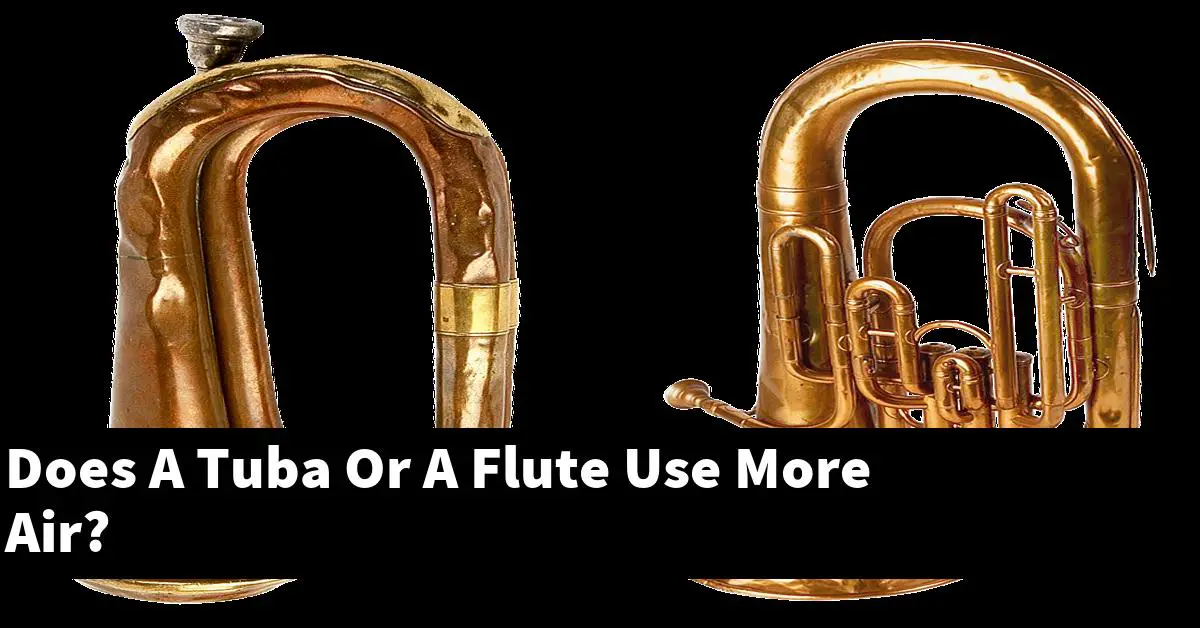The tuba and flute are both wind instruments that require a steady stream of air to produce sound. The tuba is a low-pitched brass instrument that relies on the player’s breath to create vibrations in the instrument’s large, conical brass tubing. The flute is a high-pitched woodwind instrument that uses a small stream of air directed across a metal or wooden whistle-like mouthpiece to create sound.
This article discusses how much air instruments require to produce sound. It specifically compares the tuba and the flute.
Which instrument requires more air to play – the tuba or flute?
So, which instrument requires more air to play? The answer is the tuba.
The tuba uses more air than the flute. This is because the tuba is a brass instrument, and therefore has a larger bore than the flute. The larger bore of the tuba requires more air to produce a sound.
The tuba’s large brass tubing requires a strong stream of air to create the instrument’s deep, resonant sound. The flute’s small whistle-like mouthpiece only requires a small stream of air to produce its high-pitched sound.
How do the tuba and flute compare in terms of air usage?
When considering how much air is needed to play a note on a tuba or flute, one must first understand how each instrument creates sound. Sound is produced when air is blown across an opening, causing the air to vibrate. The tuba and flute both use this fundamental principle to create sound; however, the way in which each instrument uses air is quite different.
The tuba is a brass instrument that relies on the player’s lips to vibrate the air inside the instrument. The player’s lips act as a valve, controlling the flow of air into and out of the tuba. The amount of air that is needed to produce a sound on the tuba is directly related to the size of the instrument. The larger the tuba, the more air it will require to produce a sound.
The flute, on the other hand, does not use the player’s lips to create sound. Instead, the flute uses a stream of air that is directed across a hole in the instrument. The amount of air that is needed to produce a sound on the flute is directly related to the size of the hole. The larger the hole, the more air it will require to produce a sound.
So, when considering how much air is needed to play a note on a tuba or flute, one must take into account the size of the instrument and the way in which each instrument uses air. The tuba will require more air than the flute, but the flute will require a more consistent stream of air.
How much air does a tuba or flute use when played?
The amount of air that a tuba or flute uses when played can vary depending on the size of the instrument, the player’s lung capacity, and how hard the player is blowing. A tuba can use up to 10 liters of air per second, while a flute only uses about 1 liter per second.
What is the difference in air usage between a tuba and a flute?
When it comes to playing an instrument, the amount of air that is used can vary depending on the person and the type of instrument being played. A tuba requires more air than a flute because it is a lower-sounding instrument.
The air is sent through the tuba from the player’s mouthpiece and goes down into the instrument. The player then uses their lips to vibrate the air inside the tuba, which creates the sound.
A flute, on the other hand, is a higher-sounding instrument. The air is sent through the flute from the player’s mouthpiece and goes up into the instrument. The player then uses their fingers to cover and uncover the holes on the flute, which allows the air to vibrate and create sound.
Does the flute require a lot of air?
Yes, the flute does require a lot of air. The amount of air needed depends on the range and dynamics of the music being played. In general, though, the flute requires a strong, steady stream of air. If the air supply is not strong enough, the flute will not produce a sound.
How much air does a tuba use?
Tuba players use a lot of air. The average player can use up to 10 liters per second. That’s about twice the air volume of a Brass quintet. So, how much air does a tuba use?
The answer depends on a few factors. First, how big is the tuba? Second, how hard is the player blowing? And finally, what note is being played?
A small tuba, like a 3/4 size, will use less air than a large tuba, like a tuba concerto. A player that is playing softly will use less air than a player that is playing loudly. And a low note will use more air than a high note.
So, how much air does a tuba use? It all depends on the size of the tuba, the player, and the note being played.
How much air actually goes into a flute?
The question of how much air goes into a flute is one that has puzzled musicians for years. The simple answer is that the amount of air that goes into a flute depends on the size of the flute and the type of music being played.
The amount of air that is needed to produce a sound on a flute depends on the size of the flute. The larger the flute, the more air it will need. The type of music being played also affects the amount of air that is needed. For example, classical music requires less air than jazz or rock.
So, how much air actually goes into a flute? The answer is that it depends on the size of the flute and the type of music being played.
Conclusion
So, which instrument uses more air – the tuba or the flute?
It turns out that the tuba uses more air than the flute. This is because the tuba is a lower-pitched instrument, and therefore requires more air to create the sound.
However, both instruments require a lot of air, and it is important for musicians to be able to control their breathing in order to play either one correctly.


